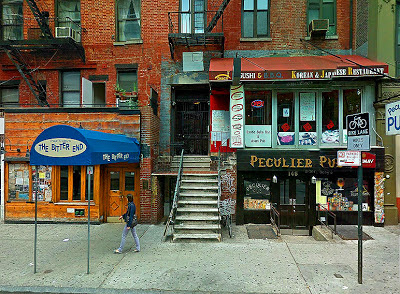 |
Sorry, but I could not resist the play on words. I have
written about New York City’s famed music venue, The Bitter End on more than
one occasion on The Compleat Traveller, and I am returning to the topic again
today.
During my August 2012 visit to the venue I recorded the
Israeli singer, Bat-Or Kalo kicking off the fortnightly Bitter End All Star
Jam, along with drummer Mark Greenberg, and bassist, Tony Tino. I recorded most
of the opening set, and now, almost a year later, I have finally gotten around
to editing the footage and producing half a dozen clips of the performance.
I spoke to Bat-Or Kalo at the end of the evening to give
voice to my appreciation for her musicianship and performance, and she
immediately handed me a flyer promoting a crowd funding campaign for a new
album she was hoping to record. She just happened to be using Kickstarter to
raise money for the CD, and since I had supported other crowd funding campaigns
via Kickstarter, I promised to make a donation. A promise I honoured the next
day.
I'm delighted to say that Bat-Or Kalo's Kickstarter campaign was a great success, and that she continues to work on the album, while touring and performing across the United States.
I'm delighted to say that Bat-Or Kalo's Kickstarter campaign was a great success, and that she continues to work on the album, while touring and performing across the United States.
I have not embedded all the videos here, but I have included
two of my favourite performances from the night, Bat-Or Kalo singing Blue
Chevy, and the eight minute rocker, Like It Or Not.
Blue Chevy
Recorded at The Bitter End on Sunday, August 12, 2012. Video
features Bat-Or Kalo (guitar/vocals), Mark Greenberg (drums), and Tony Tino
(bass),.
Like It Or Not
Recorded at The Bitter End on Sunday, August 12, 2012. Video
features Bat-Or Kalo (guitar/vocals), Mark Greenberg (drums), and Tony Tino (bass),.
You can see more videos on my YouTube page.
More Information:




